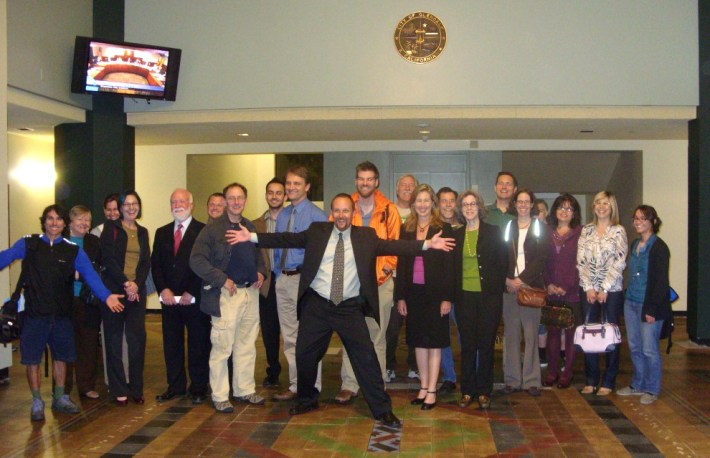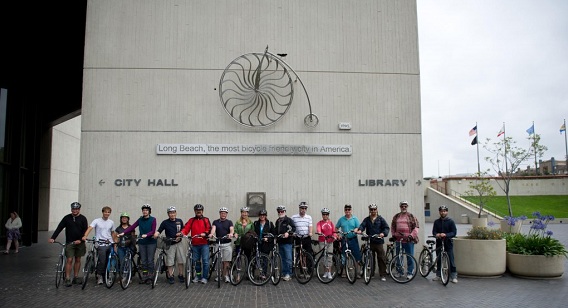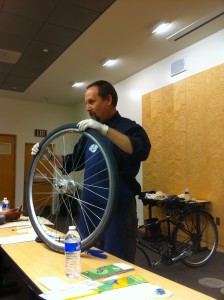The Embedded Activist
2:56 PM PDT on September 8, 2011

There's always a risk when an advocate is hired by a government agency. Will the advocate "go native" and be an ineffective agent of change? Will the advocate ever be able to shake his reputation of being "just" an advocate?
When the City of Glendale and the Los Angeles County Bicycle Coalition submitted a joint application for a Policies for Livable Active Communities and Environments (PLACE) Grant, they decided to go in a different direction then the other PLACE Communities. While the end product of their grant is the Safe and Healthy Streets Document, perhaps the best case study for other cities is how the city, LACBC and the PLACE Grant Coordinator they both hired all worked together.
The team proposed that the PLACE Coordinator would work for the LACBC as an employee, but would be embedded full-time with city staff. When Colin Bogart was hired to be the PLACE Coordinator, he worked out of an office in the Glendale Civic Center, not in Downtown Los Angeles in the LACBC offices.
“Even though he was physically removed from the office, it still didn’t feel like he was that far away,” remarked LACBC Executive Director Jennifer Klausner. “Having a full time employee, dedicated to a particular place that isn’t the headquarters, can be hard for an organization. But it never felt like he was that far away.”
It was a unique situation, even the grant makers in the L.A. County Public Health Department weren't sure how it was going to work out. But, three years later, the experiment was such a success that everyone I spoke with in Glendale to prepare for this series, from advocates, to city staff, all the way up to Mayor Laura Friedman were devastated to see Bogart go back to the LACBC's Downtown offices when the grant expired on July 1 of this year. I met with Glendale Mayor Laura Friedman two days before the grant expired and she claimed she was "in denial" that Bogart would be leaving soon.
One thing that made the PLACE Grant such a success in Glendale was that Bogart understood the advantages and limits of his somewhat unique position. Unlike PLACE Coordinators in other cities, Bogart had direct access to the decision makers in Glendale's government but could speak to advocates throughout the city as "one of them" and not a member of the city government.
There are several lessons that other cities, and advocacy groups can learn from Glendale, Bogart's and the LACBC's experience. Here are some things to consider if you work for a city or non-profit that's considering the embedded activist model for their city.
Lesson 1: Go with Someone You Can Trust

The most important thing an advocate or a city worker is the trust of the people with whom they work. For the relationship with Bogart and his employers at the LACBC, trust was never an issue.
"Colin had a long history with LACBC before the PLACE grant was ever an issue," explains Klausner. "He served as Board President, has been route master for River Ride for as long as I can remember and has been a longtime volunteer."
“He is LACBC and LACBC is him.”
The relationship with the staffers and the city took a longer time, but as time went on Bogart found himself becoming more and more a part of City Hall.
“Because I was not really a city employee I had the flexibility to do a lot of things that a city employee couldn’t do, but because of the grant, and because I was embedded in the city departments, I was part of a lot of meetings and discussions that I wouldn’t have had if I weren’t there on a full-time basis,” Bogart explains
Over the course of three years, the trust grew to the point where, as Bogart was readying to move on to the next stage in his career, the City couldn't picture life without him.
Mayor Friedman said of the PLACE Grant's ending, "It’s a shame it has to end before we have a chance to implement it (The Safe and Healthy Streets Plan).”
Of course, part of building trust is for people to know you've invested emotionally in their community. The PLACE Grant might be over, but Bogart is still sending out emails updates on the status of Safe and Healthy Streets and other events in Glendale and even recently organized a small series of bicycle/pedestrian counts.
Lesson 2: Embed Has to Be Strategic

It's not enough to gain the trust of all the stakeholders if one doesn't know what to do with that trust. In the case of Glendale, the city had been designed for car drivers and cars for decades. Despite the successful grant application, it wasn't like the city planned to turn itself into Portland overnight. The psychic wound of a backlash over an unsuccessful proposal to put bike lanes on Verdugo Avenue over a decade ago are still visible on the faces of city staff and elected leaders when the project was discussed. But, an even larger issue was that most people, be they decision makers or residents, didn't believe that there was a demand for bicycling and pedestrian projects.
“The challenge is knowing where the boundaries were, and taking things close to those boundaries and not going over the line,” Bogart explained. Thus, the initial push for bicycle projects wasn't for bike lanes, and wasn't for projects that would cause the removal of infrastructure, but for Shared Lane Markings (Sharrows) that serve as reminders that streets are for all users. The markings have proven so popular that the city is ready to move forward on a series of bike lane projects.
In addition to the first steps taken with Sharrows and other small projects, Bogart worked to educate staff on what is possible when livable streets planning is embraced. Field trips to Long Beach and Berkeley with city staff showed what some other mid-sized California cities are doing. Even when it came to Sharrows, Bogart didn't rely just on the goodwill and faith city staff had in him, but arranged for staff to see a FHWA presentation on Sharrows. When it was over, the city was intellectually ready to move forward.
“These guys that work at the City of Glendale are working hard with us too. If I took too big a step, it could make their jobs harder,” Bogart explained of his strategy.
Bogart also faced the challenge that most advocates only dream of - a political leader who is more progressive than the mainstream and ready to do more projects than perhaps the city is ready for.
“He’s been really great about cluing me in to some of the political realities based on his experiences with other cities,” remarked Friedman. When the PLACE Grant began, Friedman was a candidate for City Council and has rapidly ascended to the Mayor's Office.
Lesson 3: Embed Has to Be Available
There's an old axiom that 90% of life is just showing up. Nowhere is that more true than when you're the point person trying to bring some sort of change to a government body. In Bogart's case, he had to be available to staff, elected officials, residents and his actual employer, the LACBC. This was a particular challenge because Bogart doesn't live in Glendale, but in Los Angeles. However, by all accounts he succeeded spectacularly.
Because of Bogart's long history with the LACBC, he didn't have to be in constant contact with his co-workers with the Coalition. However, any city or non-profit looking to emulate the LACBC-Glendale-Coordinator relationship probably won't be able to find someone with the experience with the non-profit that Bogart has with LACBC, so a more day-to-day relationship might be necessary.
The most obvious way to make oneself available is to oversee a public process that leads to an involved public. Elise Kalifayan, a Glendale resident who publishes the local news website The Sunroom Desk, found the public outreach to be impressive.
"My impression was that the entire grant was so well run in Glendale, and the outreach was so comprehensive. He met with every group he could identify, he met with them as often as possible....that was one reason he got such broad support."
Kalifayan first met Bogart at a local homeowner's association meeting where he was presenting on Safe and Healthy Streets for one of the first times back in 2008. She found the presentation so compelling that she involved herself with the process the rest of the way.
In addition to fulfilling the requirement to hold meetings, Bogart programmed bike rides and special events such as Bike Month events.
Marc Stirdivant with the Glendale Parks Department was one of the original staff members who worked with the LACBC to write the original grant and hire Bogart, and he found the programmed bike events to be most impressive.
Culture change also came as a result of the rides. Ice Cream Rides. Weekend Rides. Bike to Work Rides. All of a sudden there were 60 people and they all realized they were concerned about the same things."
Or, as Friedman put it, "What Colin’s outreach has done was reach out to non-activists and turn them into activists. They’re people who are interested in commuting issues.”
By working closely with city staff, Bogart eventually became such a fixture that other staff members treated him more as a fellow city worker than a staff member for the LACBC. Kevin Carter, with the public works engineering department tells the following anecdote. “We have a tradition that if you’re quoted in the paper (we haven’t gotten to the web yet) you have to bring donuts.”
Bogart continued, “Kevin had to explain to people that ‘no, Colin is supposed to be in the paper, that’s his job’ or I would have went broke on doughnuts."
But that relationship led to real changes in the city as well. As Bogart became more a part of the culture in City Hall, other city workers sought him out for project advice.
“City staff would just stop and chat with me with questions or issues. It was tremendously rewarding and pretty useful,” remarked Bogart who was able to give input on a range of projects including bike rack placement, where to place Sharrows and even input on the bump outs that were part of a access project for a Mercedes dealership.
Because he wasn't actually a city employee, Bogart didn't have to go through the chain of command to speak to elected officials. When I first approached Bogart about this series, he was able to immediately call the Mayor's office to set up the meeting with Friedman, and he told stories of contacting other Council Members with specific issues including Friedman and her most recent predecessor Ara Najarian.
But when you tie all those relationships together, you get the real payday. Bogart was able to work on both the outside and inside at the same time. If an issue required inside discussions with city staff, or elected officials, or even a lobbying campaign he was in the best position to make it happen.
Closing Thoughts:
Perhaps the best endorsement of Bogart's time with the City of Glendale comes from Eric Knutzen, a former LACBC Board Member that was part of the team that met with Stirdivant to create Glendale's PLACE Grant application. "Being a resident of Los Angeles I had hoped to put together a grant that would benefit my neighborhood or another LA neighborhood. But the city of LA planning department wasn't interested in working with us," Knutzen said.
"I was delighted that Colin Bogart got the job and am very pleased with what he did during his years in Glendale. The experience was a nice example of how private citizens can pitch in to help local governments, in our lean economic times, get funding for projects that benefit everyone. I just wish that the City of L.A. would do a better job of working with its citizens and securing grant money. They should look to Glendale to see how it's done!"
Damien Newton wrote this story while participating in The California Endowment Health Journalism Fellowships, a program of USC’s Annenberg School for Communication & Journalism.
Stay in touch
Sign up for our free newsletter
More from Streetsblog Los Angeles
Metro Board Funds Free Student Transit Pass Program through July 2025
Metro student free passes funded another year - plus other updates from today's Metro board meeting
Eyes on the Street: New Lincoln Park Avenue Bike Lanes
The recently installed 1.25-mile long bikeway spans Lincoln Park Avenue, Flora Avenue, and Sierra Street - it's arguably the first new bike facility of the Measure HLA era
Brightline West Breaks Ground on Vegas to SoCal High-Speed Rail
Brightline West will be a 218-mile 186-mile-per-hour rail line from Vegas to Rancho Cucamonga - about 40 miles east of downtown L.A. - expected to open in 2028





